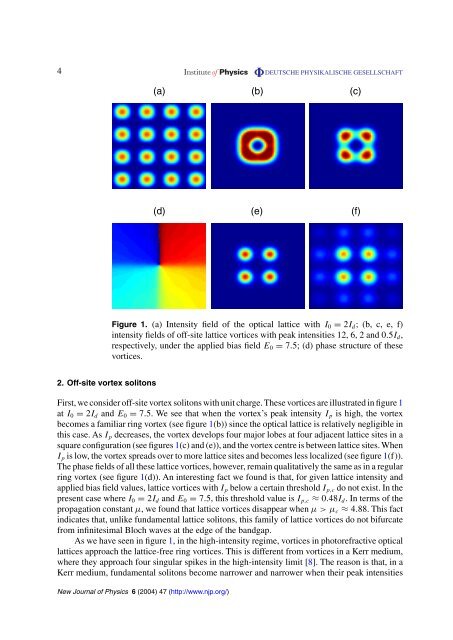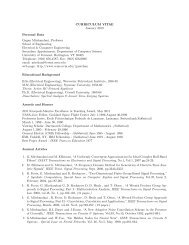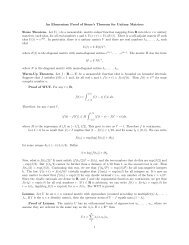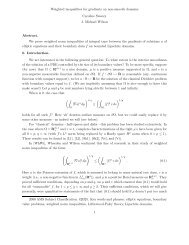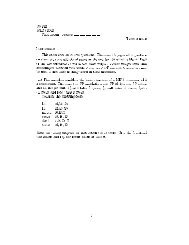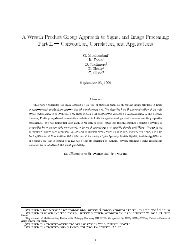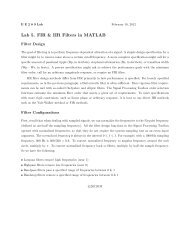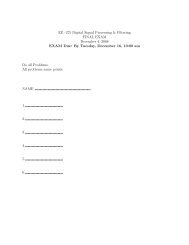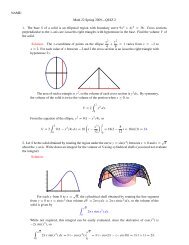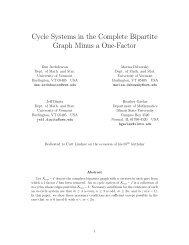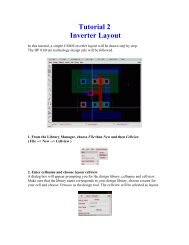4 DEUTSCHE PHYSIKALISCHE GESELLSCHAFT(a) (b) (c)(d) (e) (f)Figure 1. (a) Intensity field <strong>of</strong> the <strong>optical</strong> <strong>lattice</strong> with I 0 = 2I d ; (b, c, e, f)<strong>in</strong>tensity fields <strong>of</strong> <strong>of</strong>f-site <strong>lattice</strong> vortices with peak <strong>in</strong>tensities 12, 6, 2 and 0.5I d ,respectively, under the applied bias field E 0 = 7.5; (d) phase structure <strong>of</strong> thesevortices.2. Off-site <strong>vortex</strong> <strong>solitons</strong>First, we consider <strong>of</strong>f-site <strong>vortex</strong> <strong>solitons</strong> with unit charge. These vortices are illustrated <strong>in</strong> figure 1at I 0 = 2I d and E 0 = 7.5. We see that when the <strong>vortex</strong>’s peak <strong>in</strong>tensity I p is high, the <strong>vortex</strong>becomes a familiar r<strong>in</strong>g <strong>vortex</strong> (see figure 1(b)) s<strong>in</strong>ce the <strong>optical</strong> <strong>lattice</strong> is relatively negligible <strong>in</strong>this case. As I p decreases, the <strong>vortex</strong> develops four major lobes at four adjacent <strong>lattice</strong> sites <strong>in</strong> asquare configuration (see figures 1(c) and (e)), and the <strong>vortex</strong> centre is between <strong>lattice</strong> sites. WhenI p is low, the <strong>vortex</strong> spreads over to more <strong>lattice</strong> sites and becomes less localized (see figure 1(f)).The phase fields <strong>of</strong> all these <strong>lattice</strong> vortices, however, rema<strong>in</strong> qualitatively the same as <strong>in</strong> a regularr<strong>in</strong>g <strong>vortex</strong> (see figure 1(d)). An <strong>in</strong>terest<strong>in</strong>g fact we found is that, for given <strong>lattice</strong> <strong>in</strong>tensity andapplied bias field values, <strong>lattice</strong> vortices with I p below a certa<strong>in</strong> threshold I p,c do not exist. In thepresent case where I 0 = 2I d and E 0 = 7.5, this threshold value is I p,c ≈ 0.48I d . In terms <strong>of</strong> thepropagation constant µ, we found that <strong>lattice</strong> vortices disappear when µ>µ c ≈ 4.88. This fact<strong>in</strong>dicates that, unlike fundamental <strong>lattice</strong> <strong>solitons</strong>, this family <strong>of</strong> <strong>lattice</strong> vortices do not bifurcatefrom <strong>in</strong>f<strong>in</strong>itesimal Bloch waves at the edge <strong>of</strong> the bandgap.As we have seen <strong>in</strong> figure 1, <strong>in</strong> the high-<strong>in</strong>tensity regime, vortices <strong>in</strong> <strong>photorefractive</strong> <strong>optical</strong><strong>lattice</strong>s approach the <strong>lattice</strong>-free r<strong>in</strong>g vortices. This is different from vortices <strong>in</strong> a Kerr medium,where they approach four s<strong>in</strong>gular spikes <strong>in</strong> the high-<strong>in</strong>tensity limit [8]. The reason is that, <strong>in</strong> aKerr medium, fundamental <strong>solitons</strong> become narrower and narrower when their peak <strong>in</strong>tensitiesNew Journal <strong>of</strong> Physics 6 (2004) 47 (http://www.njp.org/)
5 DEUTSCHE PHYSIKALISCHE GESELLSCHAFTpower10 0peak <strong>in</strong>tensity10 1 (a)Growth rates0.20.150.10.050(b)stableE 0=7.5E 0=73.5 4 4.5 5Propagation constant µ1 2 3Vortex peak <strong>in</strong>tensityFigure 2. (a) Power and peak-<strong>in</strong>tensity diagrams <strong>of</strong> <strong>of</strong>f-site <strong>lattice</strong> vortices atI 0 = 2I d and E 0 = 7.5; ——, stable vortices; ----,unstable vortices. (b) Growthrates <strong>of</strong> <strong>of</strong>f-site vortices versus their peak <strong>in</strong>tensity at two applied bias fieldsE 0 = 7 and 7.5.get higher and higher. But <strong>in</strong> a <strong>photorefractive</strong> crystal where the non-l<strong>in</strong>earity is saturable,fundamental <strong>solitons</strong> flatten out when their <strong>in</strong>tensities become high (see figure 1(a) <strong>of</strong> [16]).Thus, <strong>in</strong> a <strong>photorefractive</strong> <strong>lattice</strong>, the four lobes <strong>of</strong> the <strong>vortex</strong> jo<strong>in</strong> together and form a r<strong>in</strong>g <strong>vortex</strong>at high <strong>in</strong>tensities, whereas <strong>in</strong> a Kerr <strong>lattice</strong>, the four lobes develop <strong>in</strong>to four s<strong>in</strong>gular spikes athigh <strong>in</strong>tensities.We can further determ<strong>in</strong>e the power and peak-<strong>in</strong>tensity diagrams <strong>of</strong> these vortices versus thepropagation constant µ. Here the power is def<strong>in</strong>ed as P ≡ ∫ ∞ ∫ ∞−∞ −∞ |u|2 dx dy. When I 0 = 2I dand E 0 = 7.5, the results are shown <strong>in</strong> figure 2(a). We see that the peak <strong>in</strong>tensity is a monotonedecreas<strong>in</strong>gfunction <strong>of</strong> µ, but the power is monotone-decreas<strong>in</strong>g only when µ 0.58I d .Ifµ>4.85, i.e. I p < 0.58I d , the power starts to <strong>in</strong>crease with µ.This behaviour qualitatively holds also at other I 0 and E 0 values. A similar f<strong>in</strong>d<strong>in</strong>g <strong>in</strong> the Kerrmedium has been reported <strong>in</strong> [8].Now we address the critical question <strong>of</strong> l<strong>in</strong>ear stability <strong>of</strong> these vortices <strong>in</strong> a <strong>photorefractive</strong><strong>lattice</strong>. High-<strong>in</strong>tensity <strong>lattice</strong> vortices clearly should be l<strong>in</strong>early unstable because they approachthe regular r<strong>in</strong>g <strong>vortex</strong> (see figure 1(b)) [5]. The <strong>in</strong>stability is oscillatory (i.e. the unstableeigenvalues are complex). At low <strong>in</strong>tensities, dP/dµ >0; hence the <strong>lattice</strong> vortices are expectedto be l<strong>in</strong>early unstable as well accord<strong>in</strong>g to the Vakhitov–Kolokolov (VK) criterion [17]. TheVK <strong>in</strong>stability is purely exponential (i.e. the unstable eigenvalues are purely real). How aboutthe stability behaviours <strong>of</strong> vortices at <strong>in</strong>termediate peak <strong>in</strong>tensities? To answer this question,we perturb these vortices as U ={u(x, y) + Ũ(x, y, z)}e −µz , where Ũ(x, y, z) is an <strong>in</strong>f<strong>in</strong>itesimalperturbation. When this perturbed solution is substituted <strong>in</strong>to equation (1), the l<strong>in</strong>earized equationfor perturbation Ũ(x, y, z) isiŨ z + Ũ xx + Ũ yy + µŨ −E 0(1+|u| 2 + I 0 s<strong>in</strong> 2 x s<strong>in</strong> 2 y) 2 {(1+I 0 s<strong>in</strong> 2 x s<strong>in</strong> 2 y)Ũ − u 2 Ũ ∗ }=0, (6)where the superscript ∗ represents complex conjugation. Start<strong>in</strong>g from random-noise <strong>in</strong>itialconditions, we simulate this l<strong>in</strong>earized equation for very long distances (hundreds <strong>of</strong> z units)New Journal <strong>of</strong> Physics 6 (2004) 47 (http://www.njp.org/)


